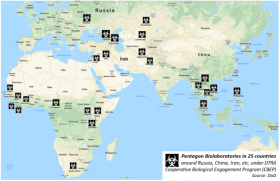US Biological Weapons Labs
Documentary Proof of the Pentagon’s Massive Bioweapons Program That Just Hit America
This devastating 2018 article that brought on an FBI crackdown gives the backgound of how the 2017 research funded by USAID/CIA at the University of North Carolina, using Wuhan Horseshoe Bat virus, may have ended up centering on the US in either a horrible “backfire” or a purposeful Deep State plot against the US.
It all began with Project Clear Vision, which is outlined below. The studies tied to this have been cleansed and published by the “on the make” academics and scientists who took the CIA’s cash and turned off their common sense and professional ethics, if such things exist anymore.
- Entomological warfare is a type of biological warfare that uses insects to transmit diseases. The Pentagon has allegedly performed such entomological tests in Georgia and Russia
- Biting Flies in Georgia In 2014 - The Lugar Center was equipped with an insect facility and launched a project “Raising Awareness about Barcoding of Sand Flies in Georgia and Caucasus”. The project covered a larger geographic area outside of Georgia – Caucasus. In 2014-2015 Phlebotomine sand fly species were collected under another project “Surveillance Work on Acute Febrile Illness” and all (female) sand flies were tested to determine their infectivity rate. A third project, also including sand flies collection, studied the characteristics of their salivary glands.
- As a result Tbilisi has been infested with biting flies since 2015. These biting insects live indoors, in bathrooms, all year long, which was not the typical behaviour of these species in Georgia previously (normally the Phlebotomine fly season in Georgia is exceptionally short – from June to September).Local people complain of being bitten by these newly appeared flies while naked in their bathrooms. They also have a strong resistance to cold and can survive even in the sub-zero temperatures in the mountains.
- Biting Flies in Dagestan, RussiaSince the start of the Pentagon project in 2014 flies similar to those in Georgia have appeared in neighboring Dagestan (Russia). According to local people, they bite and cause rashes. Their breeding habitats are house drains.
Flies in Georgia (on the left). The same fly in Dagestan (on the right)
Flies from the Phlebotomine family carry dangerous parasites in their saliva which they transmit through a bite to humans. The disease, which these flies carry, is of high interest to the Pentagon. In 2003 during the US invasion of Iraq American soldiers were severely bitten by sand flies and contracted Leishmoniasis. The disease is native to Iraq and Afghanistan and if left untreated the acute form of Leishmoniasis can be fatal.
A 1967 US Army report “Arthropods of medical importance in Asia and the European USSR” lists all local insects, their distribution and the diseases that they carry. Biting flies, which live in drains, are also listed in the document. Their natural habitats, though, are the Philippines, not Georgia or Russia.
- Source: “Arthropods of medical importance in Asia and the European USSR”, US Army report, 1967Operation Whitecoat: Infected flies tested to bite humans
In 1970 and 1972, Sand Fly Fever tests were performed on humans according to a declassified US Army report – US Army Activities in the US, Biological Warfare Programs, 1977, vol. II, p. 203.During operation Whitecoat volunteers were exposed to bites by infected sand flies. Operation Whitecoat was a bio-defense medical research program carried out by the US Army at Fort Detrick, Maryland between 1954 and 1973.
Despite the official termination of the US bio-weapons program, in 1982 USAMRIID performed an experiment if sand flies and mosquitoes could be vectors of Rift Valley Virus, Dengue, Chikungunya and Eastern Equine Encephalitis – viruses, which the US Army researched for their potential as bio-weapons.
Killer Insects
The Pentagon has a long history in using insects as vectors for diseases. According to a partially declassified 1981 US Army report, American bio warfare scientists carried out a number of experiments on insects. These operations were part of the US Entomological Warfare under the Program for Biological Weapons of the US.
The Pentagon: How to kill 625,000 people for just $0.29 cost per death
A US Army report in 1981 compared two scenarios – 16 simultaneous attacks on a city by A. Aegypti mosquitoes, infected with Yellow Fever, and Tularemia aerosol attack, and assesses their effectiveness in cost and casualties.
Operation Big Itch: Field tests were performed to determine coverage patterns and survivability of the tropical rat flea Xenopsylla cheopis for use as a disease vector in biological warfare.
Operation Big Buzz: 1 million A. Aegypti mosquitoes were produced, 1/3 were placed in munitions and dropped from aircraft, or dispersed on the ground. The mosquitoes survived the airdrop and actively sought out human blood.
Source: Evaluation of Entomological Warfare as a potential Danger to the US and European NATO nations, US Army, March 1981 Report
Operation May Day: Aedes Aegypti mosquitoes were dispersed through ground based methods in Georgia, USA, during a US Army operation codenamed May Day.
Parts of the 1981 US Army report such as the “Mass production of Aedes Aegypti” have not been declassified, potentially meaning that the project is still ongoing.
Aedes Aegypti, also known as yellow fever mosquito, have been widely used in US military operations. The same species of mosquitoes are alleged to be the vectors of dengue, chikungunya and the Zika virus, which causes genetic malformations in newborns
Aedes Aegypti, also known as yellow fever mosquito, have been widely used in US military operations. The same species of mosquitoes are alleged to be the vectors of dengue, chikungunya and the Zika virus, which causes genetic malformations in newborns









